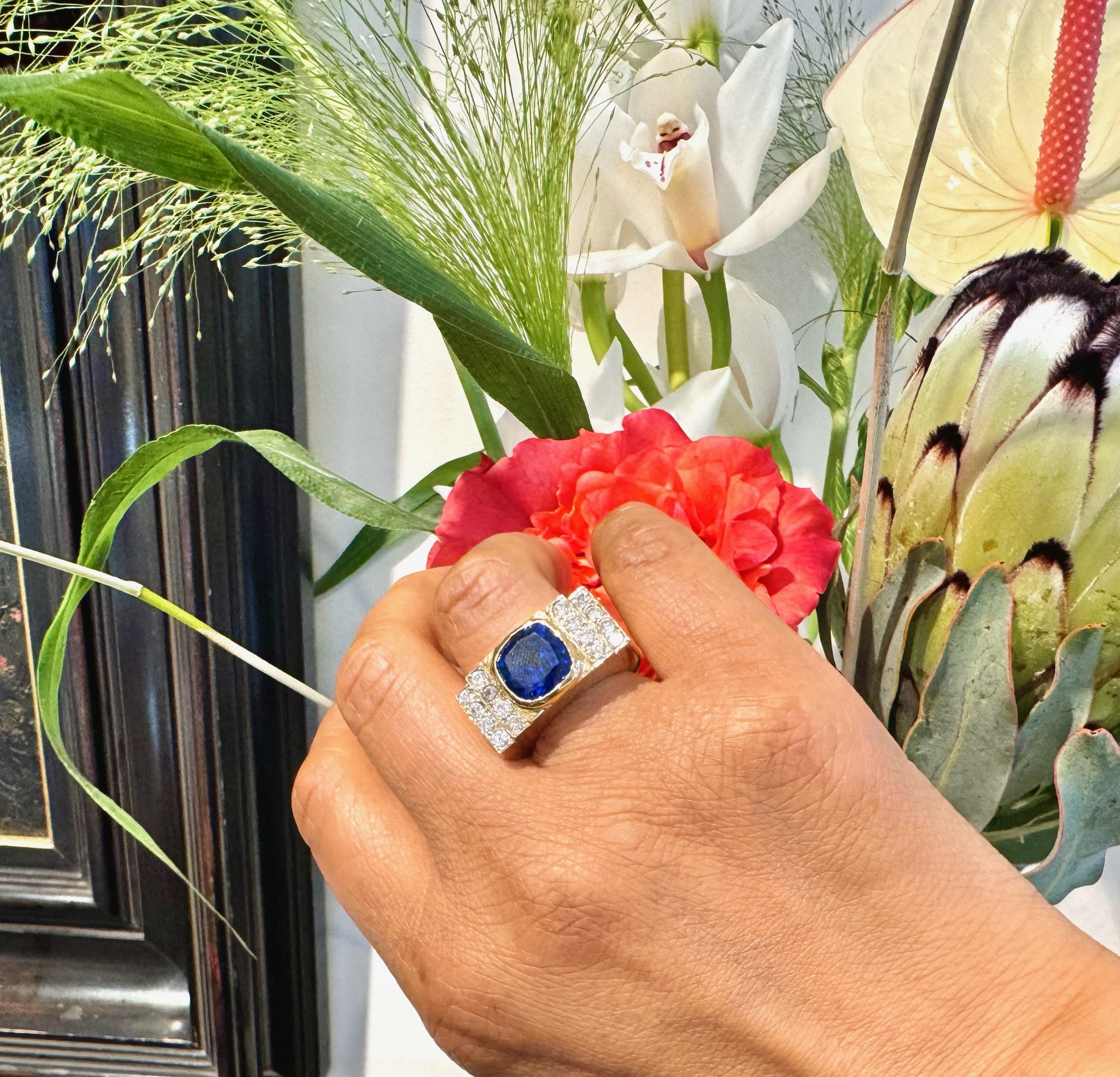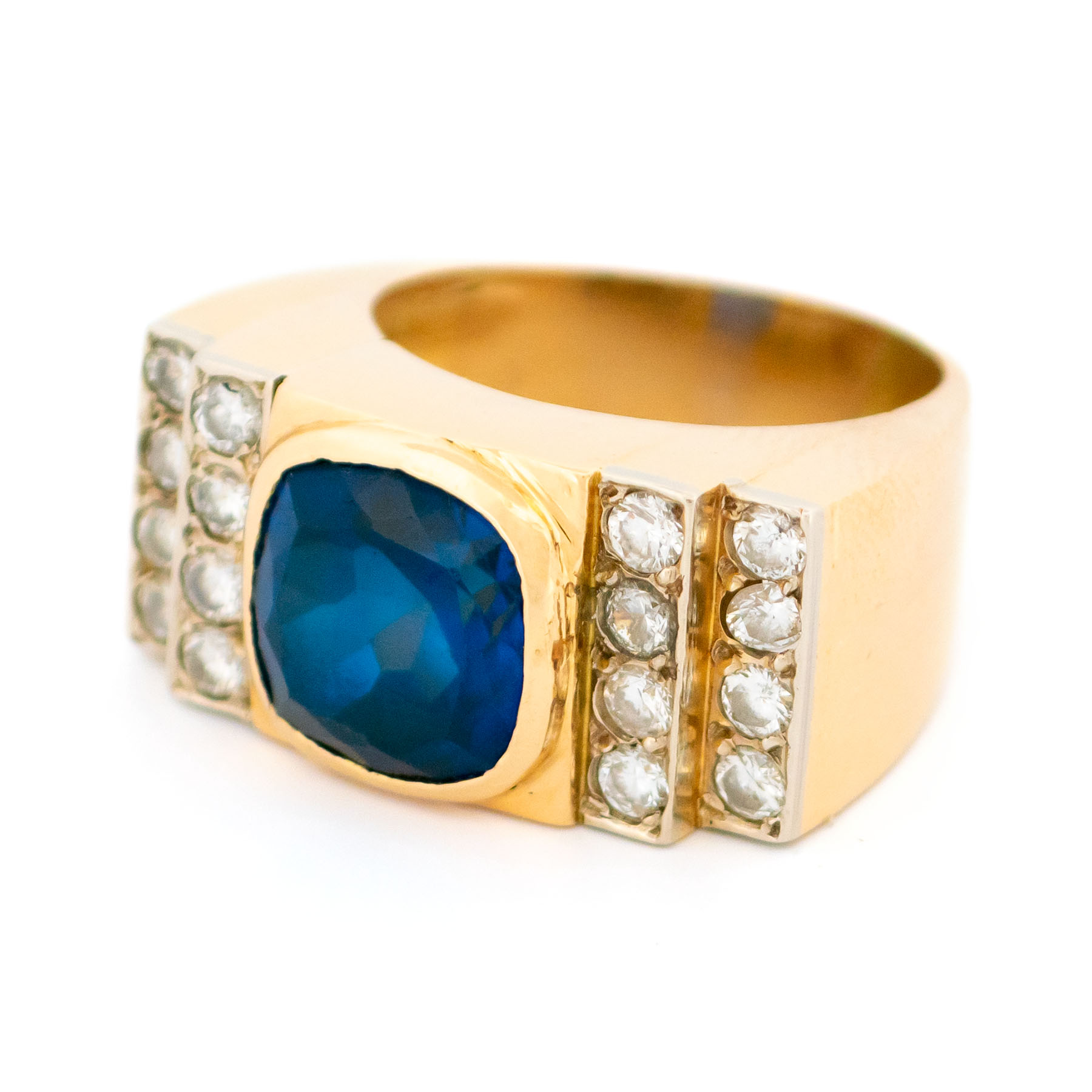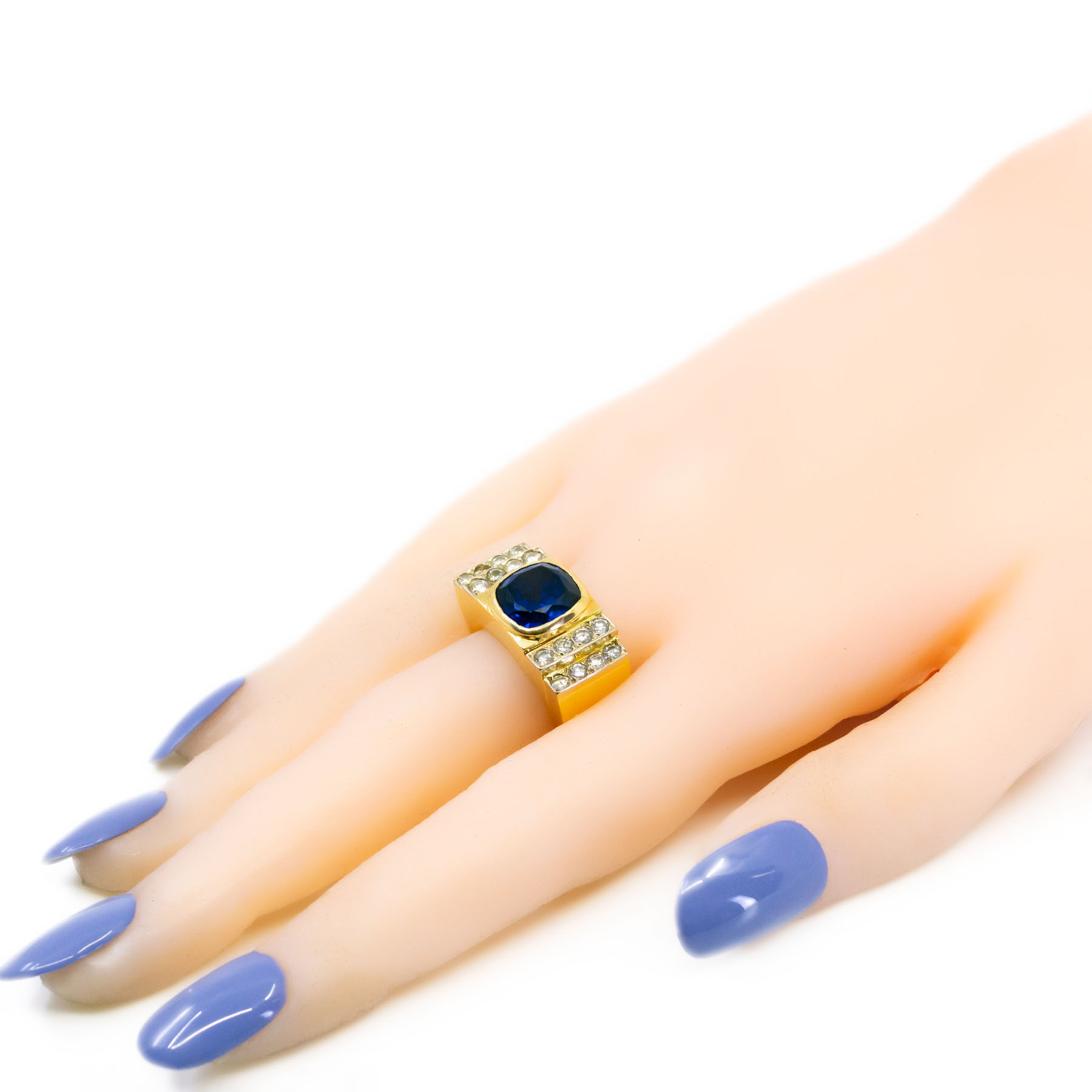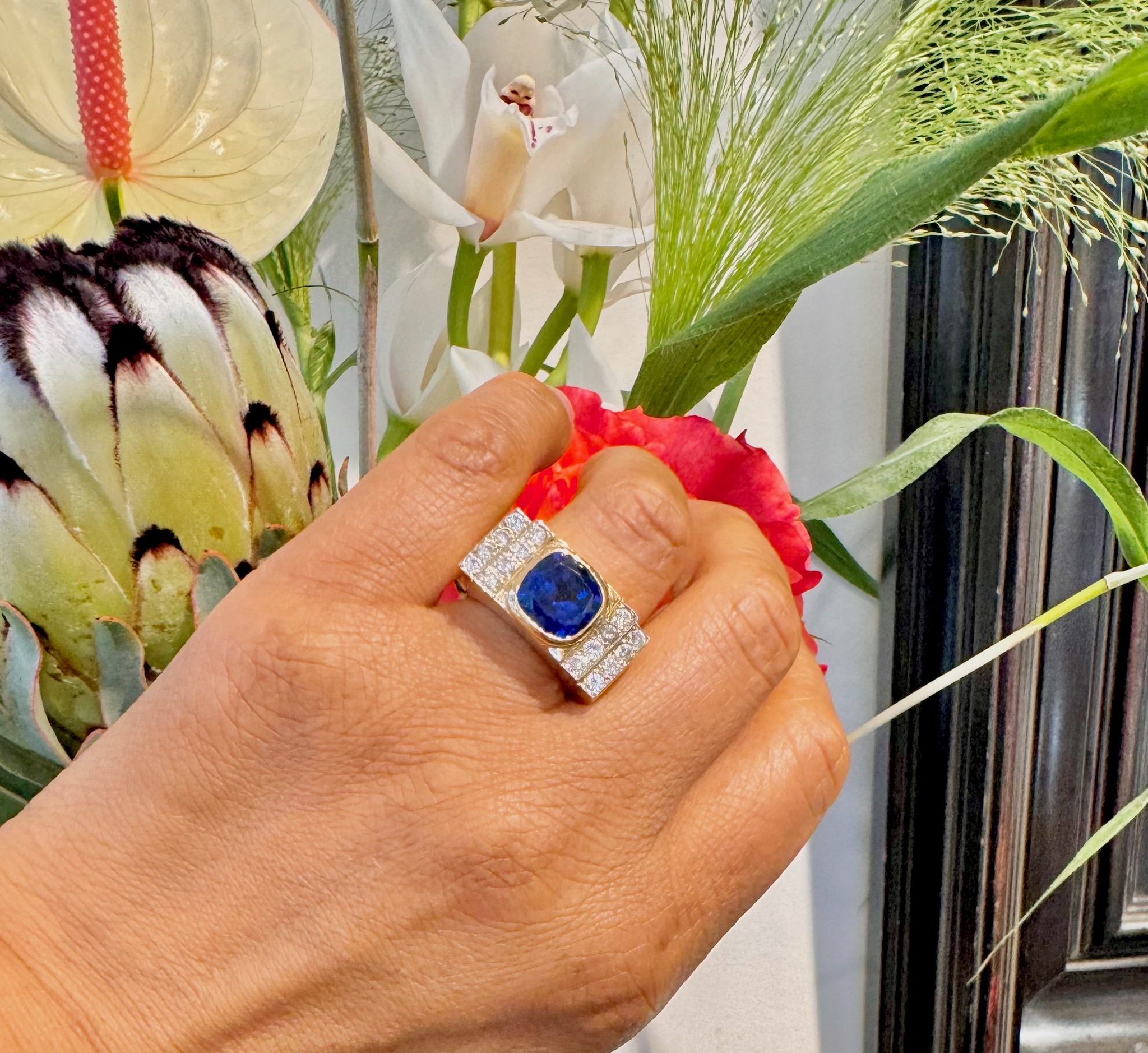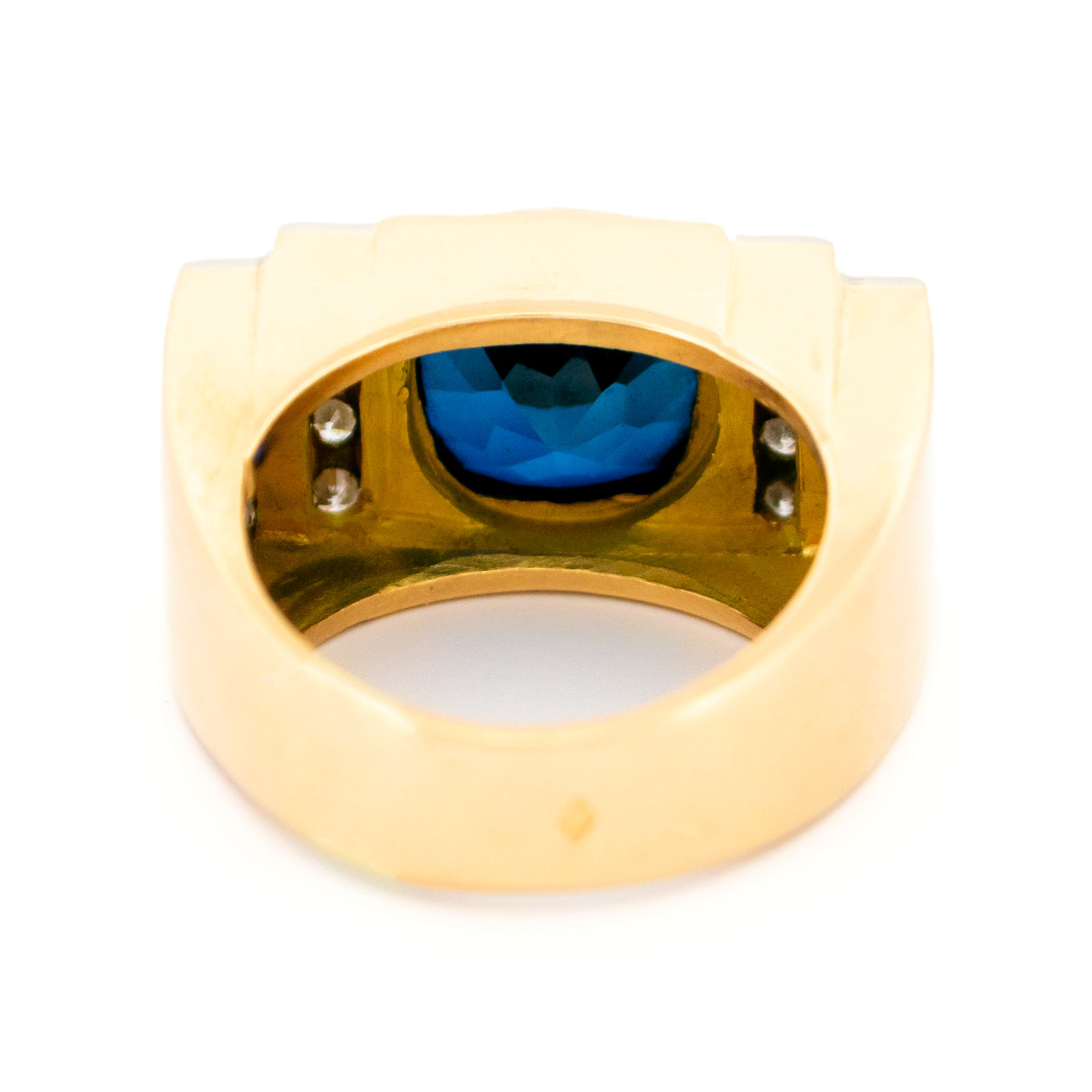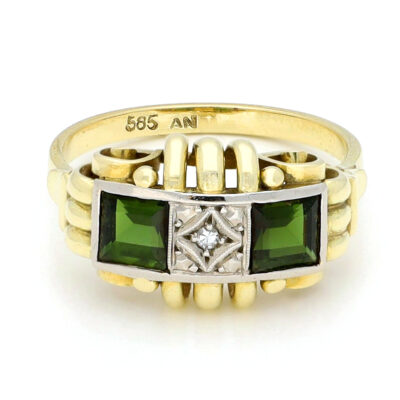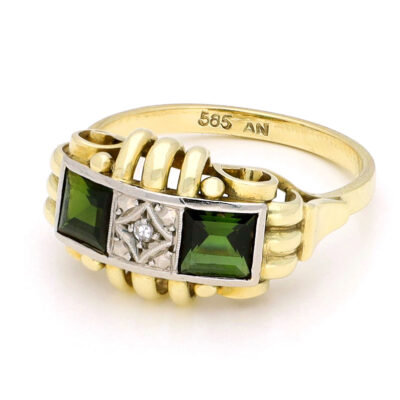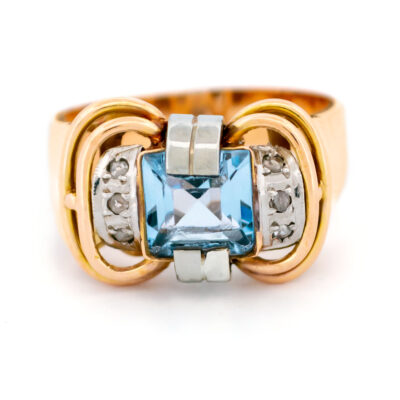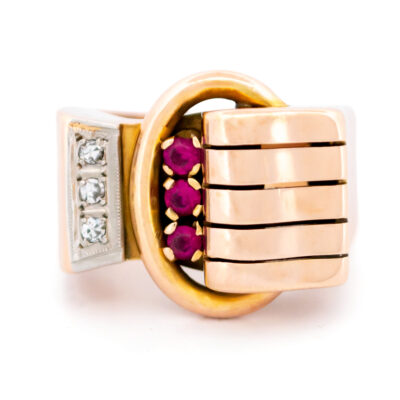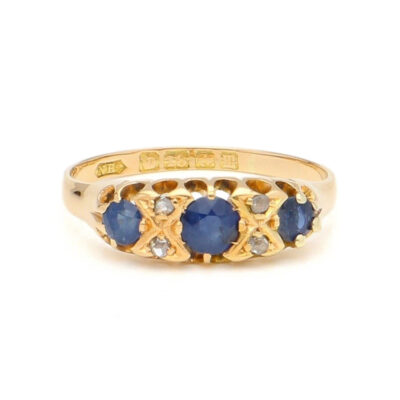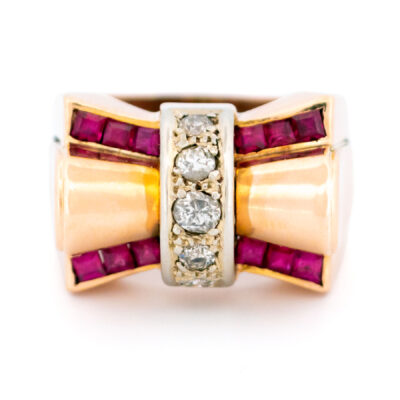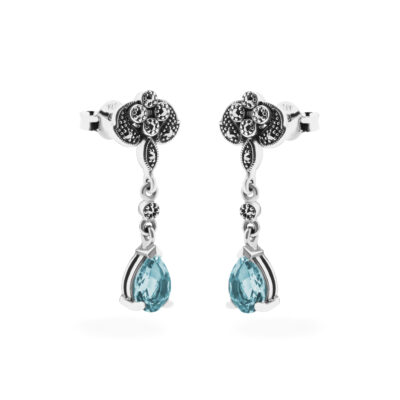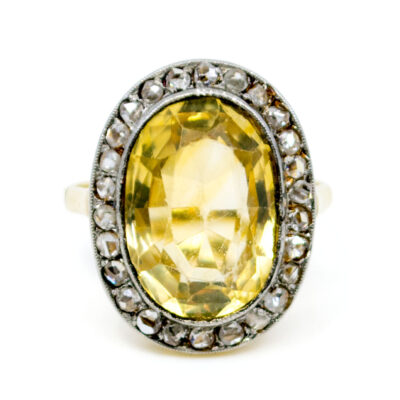Indulge in luxury with this 18k yellow gold tank ring. Featuring a striking 6.22ct lab-grown verneuil sapphire as its centerpiece, it’s complemented by 16 brilliant-cut diamonds totaling 0.88ct set in white gold. A bold and elegant statement piece. 💙
Videos
Indulge in luxury with this 18k yellow gold tank ring. Featuring a striking 6.22ct lab-grown verneuil sapphire as its centerpiece, it’s complemented by 16 brilliant-cut diamonds totaling 0.88ct set in white gold. A bold and elegant statement piece. 💙
Size: 17.53 NL / 55.1 FR / 7¼ US / O UK, sizeable (within reason).
Dimensions: Front: 12 x 24 mm .
Weight in grams: 17.
Condition: Very good condition – slightly used with small signs of wear.
| Design Era | |
|---|---|
| Design & Historical Context | The jewelry industry was significantly impacted by the onset of World War II in the 1940s. Precious metals, particularly platinum, became scarce and in some cases were even banned from being sold. Palladium was used as a substitute for platinum in the war effort. In order to make the most of the limited supply of gold, a low karat gold alloy with a higher percentage of copper was used. This resulted in gold with a subtle, reddish hue, but through the use of different alloys, gold was able to appear in a range of colors within a single piece. Gold was also manipulated in various ways, such as being woven, braided, and coiled. Techniques like resilla, cannetille, and lacy filigree patterns reappeared in jewelry. Different textures were also used within a single design, with matte finishes being placed next to bright finishes to accentuate the design. Gold became the primary metal used in jewelry during the 1940s and 1950s. |
| Key Materials | |
| Materials & Craftsmanship | Verneuil sapphire: The Pioneering Gem of Man-Made Brilliance Verneuil sapphire, also known as lab-grown sapphire, is a type of sapphire created using the Verneuil process, a pioneering method developed in the late 19th century by French chemist Auguste Verneuil. This process, also known as flame fusion, was the first successful technique for producing lab-grown gemstones, allowing for the creation of sapphires that closely mimic their natural counterparts in both appearance and properties. Historically, the development of the Verneuil process was a significant breakthrough in gemology. Introduced in 1902, this method involves melting aluminum oxide (the primary component of sapphire) and adding trace elements to produce the desired color. The molten material is then crystallized into a boule—a cylindrical crystal—that is later cut and faceted into gemstones. The process made it possible to create high-quality sapphires that were affordable and widely available, revolutionizing the jewelry industry. In modern jewelry, Verneuil sapphires are valued for their exceptional clarity, vibrant color, and durability, making them a popular choice for a wide range of jewelry, including rings, earrings, necklaces, and bracelets. These lab-grown sapphires are chemically identical to natural sapphires, with the same hardness (9 on the Mohs scale) and optical properties, but are often more affordable due to their man-made origin. Verneuil sapphires come in a variety of colors, most commonly the deep blue associated with traditional sapphires, but they can also be produced in pink, yellow, green, and even colorless varieties. Their consistent quality and availability make them a popular choice for those who want the beauty of sapphire without the higher cost of natural stones. Beyond jewelry, Verneuil sapphires are also used in various industrial applications, including in electronics and watchmaking, due to their hardness and resistance to scratching. Verneuil sapphire is more than just a gemstone; it represents a milestone in the history of gemology and the democratization of luxury. Its creation marked the beginning of lab-grown gemstones, making beautiful, high-quality sapphires accessible to a broader audience. Whether set in a simple piece or an elaborate design, Verneuil sapphires offer the brilliance and durability of natural sapphires, with the added allure of being a product of human ingenuity. Brilliant-cut diamond: The Pinnacle of Sparkle and Brilliance The brilliant-cut diamond is the most popular and widely recognized diamond cut in the world, renowned for its exceptional sparkle and fire. This cut, perfected over centuries, is designed to maximize the reflection of light, creating the dazzling brilliance that has made it the standard for diamonds in modern jewelry. The brilliant cut features 58 facets—33 on the crown and 25 on the pavilion—carefully arranged to capture and reflect light from every angle. The precision of these facets ensures that light entering the diamond is reflected internally and dispersed into a stunning array of colors, giving the stone its characteristic brilliance. Historically, the brilliant cut evolved from earlier cuts like the Old European and rose cuts, with advancements in diamond cutting technology and understanding of light reflection. This modern cut became widely adopted in the early 20th century and quickly became the preferred choice for engagement rings and other fine jewelry, due to its unmatched sparkle. In modern jewelry, brilliant-cut diamonds are prized for their versatility and unmatched brilliance. They are the go-to choice for engagement rings, earrings, pendants, and virtually any jewelry piece where a classic, sparkling diamond is desired. The round shape and symmetrical design make the brilliant cut ideal for showcasing the inherent beauty of the diamond, regardless of its size. A brilliant-cut diamond is more than just a gemstone; it is a symbol of timeless beauty and perfection. Its unparalleled sparkle and universal appeal make it the quintessential choice for jewelry that celebrates life's most precious moments. 18k: The Perfect Balance of Luxury and Durability 18k gold is a luxurious and highly sought-after material in the world of fine jewelry, known for its rich color, durability, and value. The "18k" refers to the purity of the gold, indicating that it is composed of 75% pure gold and 25% alloyed metals, such as copper, silver, or palladium. This combination provides the perfect balance between the softness of pure gold and the strength needed for creating durable jewelry. Historically, gold has been prized for its beauty and rarity, symbolizing wealth, power, and status across various cultures and civilizations. 18k gold has been a preferred choice in fine jewelry for centuries due to its ideal blend of purity and strength, offering a radiant gold color that is more vibrant than lower karat golds while still being hard enough for everyday wear. In modern jewelry, 18k gold is favored for its versatility and its ability to enhance the appearance of gemstones. It is available in several colors, including yellow, white, and rose gold, depending on the metals used in the alloy. Each color has its unique appeal: Yellow Gold: The classic choice, offering a warm, rich hue that pairs beautifully with a wide range of gemstones and complements all skin tones. White Gold: A sleek, modern option that resembles platinum or silver but with the strength and luxury of gold. It is often rhodium-plated to enhance its reflective surface. Rose Gold: A romantic, pinkish hue that has gained popularity for its vintage charm and contemporary appeal, achieved by alloying gold with copper. 18k gold is commonly used in engagement rings, wedding bands, earrings, necklaces, and bracelets, where its balance of durability and beauty makes it ideal for both intricate designs and simple, elegant pieces. The alloy's added strength ensures that jewelry can withstand daily wear while maintaining its luster and shape. 18k gold is more than just a material; it is a symbol of refined taste and enduring value. Its perfect blend of luxury and practicality makes 18k gold a timeless choice for those who seek the beauty of high-purity gold without sacrificing durability. Whether in classic or modern designs, 18k gold jewelry offers a radiant and lasting expression of elegance and sophistication. |
| Size | |
| Dimensions | Front: 12 x 24 mm |
| Gender | |
| Weight (in grams) | 17 |
| Condition | Very good condition – slightly used with small signs of wear |
By following these tips, you can enjoy your precious jewelry for many years to come.
Related Products
-
Diamond Sapphire 18k Band Ring 16229-8756
€ 3.895,00 VAT incl. (where applicable) -
Diamond Sapphire 18k Ring 16158-8726
€ 1.995,00 VAT incl. (where applicable) -
Diamond Tourmaline Ring 18351-9480
€ 1.895,00 VAT incl. (where applicable) -
Diamond Sapphire 18k Row Ring 17553-9241
€ 3.895,00 VAT incl. (where applicable) -
Diamond Spinel 18k Tank Ring 17289-9145
€ 3.295,00 VAT incl. (where applicable) -
Diamond Ruby 14k Tank Ring 17309-9165
€ 2.495,00 VAT incl. (where applicable) -
Diamond Sapphire 18k Row Ring 16514-8860
€ 1.895,00 VAT incl. (where applicable) -
Diamond Ruby 14k Tank Ring 16232-8759
€ 3.395,00 VAT incl. (where applicable)
- Home
- Collection
- Fine Jewelry
- Silver Jewelry
- Silverware
- Boxes
- Candlesticks
- Salt and pepper shakers
- Miniatures
- Salt cellars
- Spoon Set
- Condiments
- Frames
- Napkin Ring
- Spoon
- Oddities
- Cups
- Vases
- Cutlery
- Serving Spoon And Cake Server
- Candlesticks
- Baskets
- Hanukkiah
- Spice Tower
- Yad
- Tea Set
- Sugar Castor
- Napkin Rings
- Wine Bottle Coaster
- Wine Stopper
- Tea Pot
- Jugs
- Rattles
- Hip Flask
- Miscellaneous
- Rings 💍
- About
- Contact
- No products in the cart.

